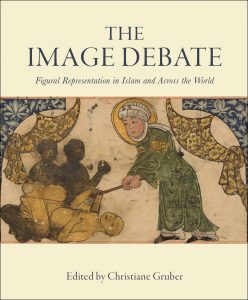Working to improve mutual understanding between the Middle East and the West
Working to improve mutual understanding between the Middle East and the West
No products in the basket.
The nine essays in this volume were first presented at the Historians of Islamic Art Association’s (HIAA) seventh biennial symposium entitled ‘Regime Change’ and they highlight some of the regimes of thought and changing trends that structure the field of Islamic art history. The authors present new research exploring the intentions of patrons, the agency of craftsmen and their responses to previous artistic production, thereby allowing artefacts and monuments to
be set within their historical, social and artistic contexts.
In their contributions Annabel Teh Gallop, Dmitry Bondarev and Umberto Bongianino discuss significant changes to Qurʾan production due to dynastic and political regime changes in Sumatra and the Malay peninsula, and in Borno and Morocco in Africa. Corinne Mühlemann looks at changes in the role and status of designers and weavers making silk in Khurasan in the post-Mongol period. Lisa Golombek, Michael Chagnon, and Farshid Emami explore Safavid art and architecture, focusing on the material and sensorial qualities of a group of tiled arch panels with narrative scenes, a delicately painted vase and the clocks of the main square of seventeenth-century Isfahan. Regime change also comes about through technological shifts and in their essays Ulrich Marzolph and Yasemin Gencer ask how the rise of photography and new printing techniques shaped the production, exchange and transmission of images in Iran and Turkey.
Christiane Gruber is Professor of Islamic Art in the History of Art Department at the University of Michigan as well as Founding Director of Khamseen: Islamic Art History Online. Her scholarship explores medieval to contemporary Islamic art, especially figural representation, depictions of the Prophet Muhammad, book arts, architecture, and visual and material cultures. Two recent publications include The Praiseworthy One: The Prophet Muhammad in Islamic Texts and Images (Indiana University Press, 2019) and The Image Debate: Figural Representation in Islam and Across the World (GINGKO, 2019).
Bihter Esener is Lecturer of medieval Mediterranean and Islamic art in the History of Art Department at the University of Michigan. She is an art historian of the visual and material cultures of the medieval Islamic world, with a special interest in Armenian, Byzantine, and Persian-Islamic artistic exchange and cultural encounters in medieval Anatolia, the SouthCaucasus, and the Eastern Mediterranean. She is one of the founding members of Khamseen: Islamic Art History Online.
Contributors: Dmitry Bondarev, Umberto Bongianino, Michael Chagnon, Farshid Emami, Annabel Teh Gallop, Yasemin Gencer, Lisa Golombek, Ulrich Marzolph, Corinne Mühlemann.
| Weight | 1 kg |
|---|---|
| Theme | Art |
1. ISLAMIC ART IN THE THIRD MILLENNIUM: FROM REGIMES TO HORIZONS Christiane Gruber and Bihter Esener 6
2. MIGRATING MANUSCRIPT ART: THE ‘SULAWESI DIASPORA GEOMETRIC’ STYLE OF QURʾANIC ILLUMINATION Annabel Teh Gall op 14
3. SHIFTING REGIMES, RESHAPING MANUSCRIPTS: THE DISAPPEARANCE OF ANNOTATED QURʾANS IN BORNO Dmitry Bondarev 32
4. THE RE-ENDOWMENT OF ALMOHAD QURʾANS UNDER THE EARLY MARINIDS (CA. 1250–1300 CE) Umberto Bongianino 48
5. THE WEAVER’S SIGNATURE? THE DIVISION OF LABOUR IN THE PRODUCTION OF LAMPAS WOVEN SILKS Corinne Mühlemann 64
6. POINTS OF VISION: RECEPTION OF A LATE SAFAVID TILED ARCADE Lisa Golombek 80
7. INTERPRETING A LATER SAFAVID VASE: BETWEEN MATERIAL, OBJECT AND IMAGE Michael Chagnon 96
8. SENSING TIME AND SOUND IN SAFAVID ISFAHAN: THE CLOCKS OF THE MAYDAN-I NAQSH-I JAHAN Farshid Emami 110
9. LITHOGRAPHY AND ITS IMPACT ON THE ART OF ILLUSTRATION IN IRAN Ulrich Marzolph 128
10. MUSTAFA KEMAL, PHOTOGRAPHY AND IMAGE IN 1920S TURKISH MEDIA Yasemin Gencer 144
AUTHOR BIOGRAPHIES 160

‘Regime Change is the latest title in the Gingko Art Series. It is a heavily illustrated, beautifully produced collection of essays by leading art historians, covering topics from Qur’anic illumination amongst the Sulawesi diaspora to the woven silks of Khurasan, and the clocks of the Maydan-i Naqsh-i Jahan in Isfahan to photography and image making in 1920s Turkey. […] The wide-ranging subject matter is such that both specialists and amateur admirers of Islamic art will find something engaging and new in Regime Change. […] The strength of Regime Change is that it pulls together scholarship on diverse subjects without losing the sense of overall cohesion’.
Sophie Ibbotson, Asian Affair
‘The articles in this handsome volume reflect the broad range of research interests, issues and methodologies pursued within the Historians of Islamic Art Association community and highlight current, innovative developments in the study of Islamic material culture and the visual arts. In the aggregate they also offer multiple perspectives on the concept of ‘regime change’: historical, typological, technological, and— most intriguingly—metaphorical and symbolic.’
Dr. Marianna Shreve Simpson, Past President (2011‒13), Historians of Islamic Art Association
‘The articles in this volume amply fulfil the promise of its title. They exemplify the recent expansion of Islamic art into previously underresearched areas such as southeast Asia and sub-Saharan Africa, as well as the conceptual exploration of new fields of sensory and auditory matters, and temporal extension into the twentieth century. The shift to looser definitional boundaries is much to be welcomed.’
Prof. Bernard O’Kane, The American University in Cairo
Our work relies on the generous support of our donors. Any contribution, no matter how small, helps us achieve our aims.